Mon - Fr 9:00 am - 5:30 pm
3760 Oceanic Way STE 501, Oceanside, CA 92056
Posted by Gen819 Comments Off on Things You Should Know About Your Roof As A Homeowner Residential Roofing
Things You Should Know About Your Roof As A Homeowner
As a homeowner, your roof is one of the most critical components of your house. It serves as the first line of defense against the elements, protecting everything and everyone inside. A well-maintained roof not only ensures the safety and comfort of your home but also enhances its overall value. Understanding your roof’s needs, its material, and how to care for it is essential in preventing costly repairs and extending its lifespan. Being proactive about your roof’s health can save you time, money, and stress in the long run.
Geographic Considerations
Living in Vista, CA, and the surrounding San Diego County area presents unique challenges for homeowners when it comes to roofing. The region’s Mediterranean climate, characterized by hot, dry summers and mild, wet winters, can take a toll on roofing materials over time. Additionally, the proximity to the ocean means that roofs may be exposed to salt air, which can accelerate wear and tear, especially on metal components. Local factors like high UV exposure and occasional strong winds also play a significant role in roof degradation. Understanding these geographic considerations is crucial for selecting the right roofing materials and maintenance practices to ensure your roof stands the test of time in this particular environment.
Roofing Material Choices: Finding the Best Fit for Your Home
Exploring San Diego’s Most Popular Roofing Materials
1. Asphalt Shingles: Affordable and Versatile
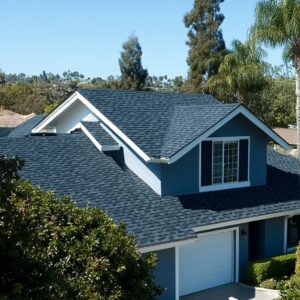
Asphalt shingles are relatively easy to install and provide decent protection against the elements. However, they have a shorter lifespan compared to other materials, typically lasting around 20 to 30 years. They may also be less resistant to the intense UV radiation common in Southern California.
2. Clay and Concrete Tiles: Durability Meets Style
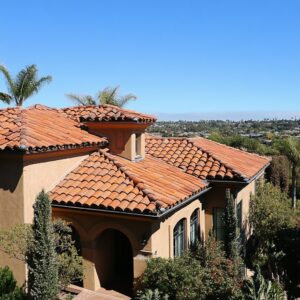
However, their significant weight requires a strong underlying structure, which may necessitate additional support. While the initial cost is higher than asphalt shingles, their longevity and low maintenance requirements make them a worthwhile investment for many homeowners.
3. Metal Roofing: Modern, Long-Lasting, and Energy Efficient
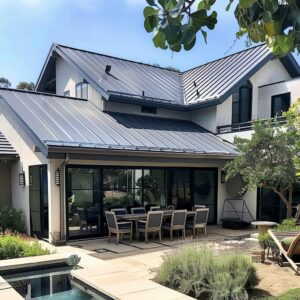
They reflect solar radiant heat, which can reduce cooling costs, particularly in hot climates like San Diego’s. However, metal roofs can be more expensive upfront, and some homeowners may be concerned about noise during heavy rain, though modern installations can mitigate this issue.
4. Wood Shingles and Shakes: Natural Beauty with a Rustic Charm
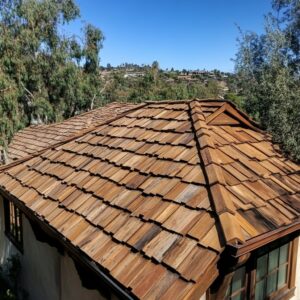
However, wood is more susceptible to fire, insect damage, and rot, particularly in humid conditions or areas close to the coast. Regular maintenance, such as applying preservatives and treatments, is necessary to prolong the lifespan of a wood roof, which typically ranges from 20 to 40 years.
5. Flat Roofs: Sleek Design for Modern Homes

Picking the Right Material for San Diego’s Weather
When selecting roofing materials in San Diego County, it’s essential to consider the local climate. High UV exposure in the area can cause materials to deteriorate faster, making UV-resistant options like metal or tile more appealing. Additionally, the region’s occasional heavy rains and proximity to the coast necessitate materials that resist moisture and salt damage.
For instance, while wood shingles may look attractive, they might not hold up well without extensive maintenance. Reflective materials like metal roofing can also reduce cooling costs by deflecting sunlight, which is an essential consideration given the area’s hot summers. By choosing materials suited to these specific climate conditions, homeowners can ensure their roofs are both durable and energy-efficient.
Roof Maintenance and Inspections: Keeping Your Roof in Top Shape
Regular Maintenance: Simple Steps for a Long-Lasting Roof
1. Gutter Cleaning: Preventing Water Damage
Cleaning your gutters regularly is essential for preventing water damage to your roof and home. Clogged gutters can cause water to back up under the roof, leading to leaks, rot, and even structural damage. By ensuring gutters are clear, especially after heavy winds or storms, you can protect your roof and extend its lifespan.
2. Debris Removal: Avoiding Mold and Decay
Leaves, branches, and other debris can accumulate on your roof, especially in areas surrounded by trees. This debris can trap moisture, leading to mold, algae growth, and even roof deterioration over time. Regularly removing debris, either by yourself or through a professional service, helps prevent these issues and keeps your roof in optimal condition.
3. Damage Check: Spotting Problems Early
Regularly checking your roof for visible signs of damage, such as missing or cracked shingles, damaged flashing, or worn areas, can prevent minor issues from becoming major problems. Addressing these issues early through simple repairs can save you from costly and extensive repairs later. It’s a crucial part of maintaining the overall integrity of your roof.
Professional Inspections: The Value of an Expert’s Eye
While regular self-checks are important, professional roof inspections are critical for detecting issues that may not be visible to the untrained eye. It’s recommended to have your roof professionally inspected at least once a year or after significant weather events. Professionals can assess the condition of your roof, identify potential problem areas, and provide recommendations for maintenance or repairs. They can also check less accessible areas, like underlayment or ventilation systems, ensuring your roof is in top condition. Regular inspections can prolong the life of your roof, help maintain warranties, and give you peace of mind about your home’s safety.
The Cost of Neglect: Why Regular Maintenance Pays Off
Neglecting regular maintenance and inspections can lead to significant and costly issues over time. Small problems, such as leaks or damaged shingles, can quickly escalate into major structural damage, requiring expensive repairs or even a full roof replacement. Additionally, neglecting your roof can reduce your home’s energy efficiency and negatively impact its overall value.
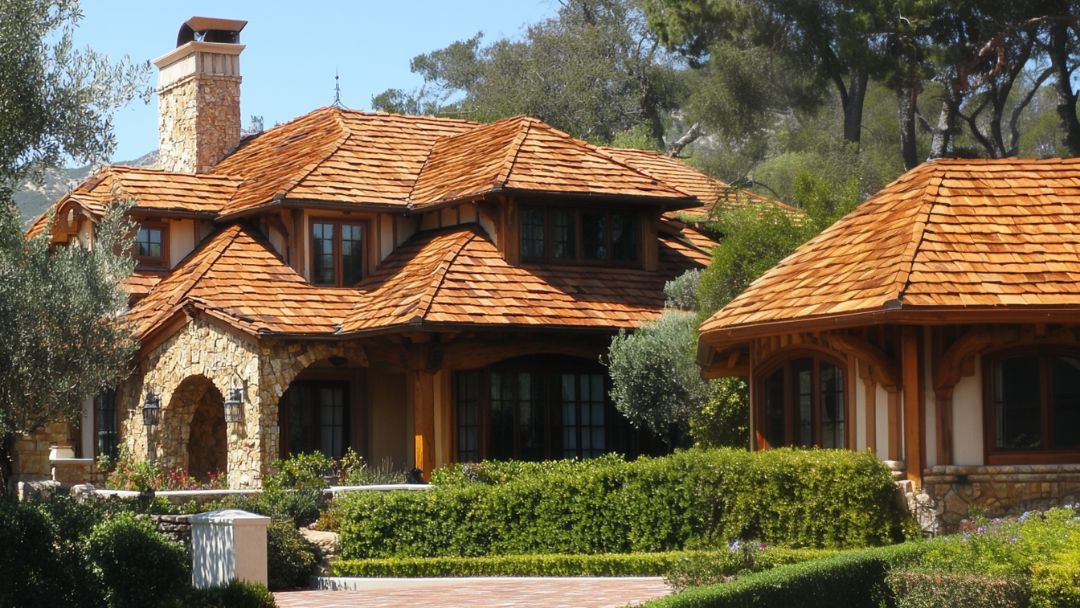
Roof Repairs vs. Replacement: Making the Right Decision
When a Repair is Enough: Addressing Minor Issues
Roof repairs are typically the best option when the damage is localized and not widespread. Common scenarios for repairs include fixing small leaks, replacing a few missing or damaged shingles, or repairing flashing around chimneys and vents.
If your roof is relatively new and generally in good condition, addressing these minor issues promptly can prevent them from escalating into more significant problems. Repairs are also more cost-effective than replacements and can extend the life of your roof by several years.
However, it’s crucial to ensure that repairs are done by a professional to avoid improper fixes that might lead to further damage down the line.
Knowing When to Replace: Signs It’s Time for a New Roof
A full roof replacement is necessary when the damage is extensive, or the roof has reached the end of its expected lifespan. Signs that it might be time for a replacement include widespread shingle deterioration, recurring leaks, or visible sagging in the roof structure. If your roof is 20-30 years old, depending on the material, it may no longer provide adequate protection and efficiency. Additionally, if repairs are becoming frequent and costly, a replacement might be more economical in the long run. A new roof not only improves the safety and energy efficiency of your home but also enhances curb appeal and increases property value, making it a worthwhile investment for homeowners.
Boosting Energy Efficiency with Smart Roofing Choices
Cool Roofs: Reflective Materials for Hot Climates
Reflective roofing materials, often referred to as “cool roofs,” are designed to reflect more sunlight and absorb less heat compared to standard roofing materials. In a warm climate like San Diego County, these materials can significantly reduce the amount of heat entering your home, leading to lower cooling costs. Options like light-colored asphalt shingles, metal roofing with reflective coatings, or tiles with high solar reflectance can decrease your energy consumption and make your home more comfortable during hot summer months. Investing in reflective roofing not only saves money but also contributes to a more sustainable and eco-friendly household.
Insulation and Ventilation: The Dynamic Duo of Energy Efficiency
Proper insulation and ventilation are key to maintaining energy efficiency in your home. Insulation acts as a barrier to heat loss and gain, keeping your home warmer in the winter and cooler in the summer. In contrast, ventilation ensures that hot air can escape from your attic, preventing heat buildup that can lead to higher energy bills and reduced roof lifespan. Together, these systems work to balance your home’s temperature, reduce strain on your HVAC system, and protect your roof from moisture-related issues. A well-insulated and ventilated roof can drastically improve your home’s energy efficiency and comfort.
Solar Panels: Powering Your Home with the Sun
Installing solar panels on your roof is an excellent way to harness the abundant sunshine in Southern California. Solar panels can drastically reduce or even eliminate your electricity bills, increase your home’s value, and lower your carbon footprint. When integrating solar panels, it’s essential to consider your roof’s age, material, and orientation to ensure optimal performance.
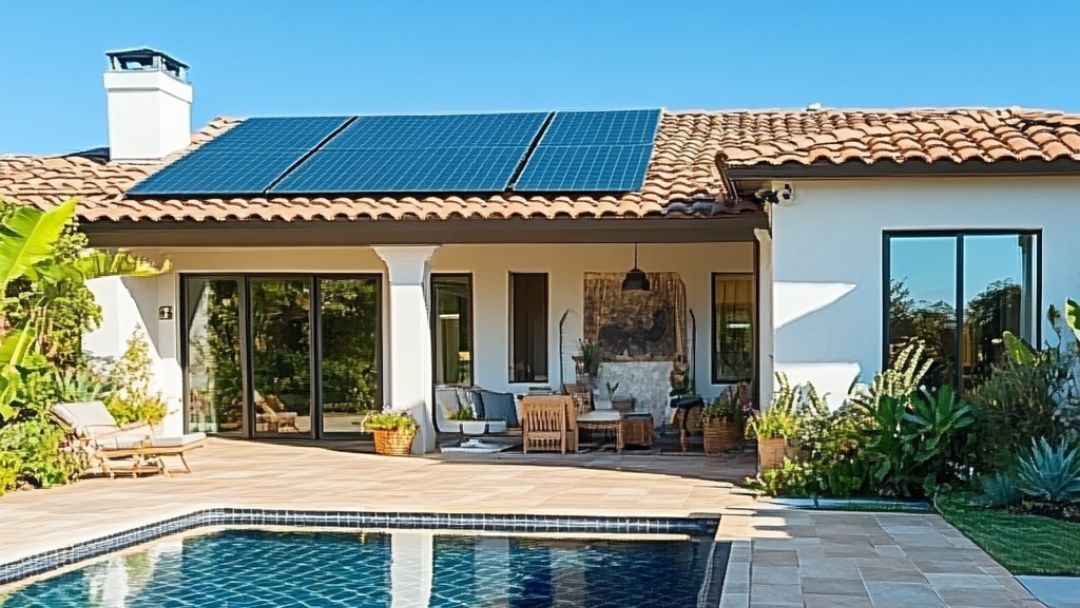
Tackling Common Roofing Problems Head-On
Leaks and Water Damage: Spotting Trouble Before It Spreads (100 words)
Leaks are one of the most common roofing issues and can lead to significant water damage if not addressed promptly. Small leaks, often caused by damaged shingles, cracked flashing, or improperly sealed roof penetrations, can quickly escalate into larger problems, including rot, mold, and structural damage. It’s essential to inspect your roof regularly for signs of water intrusion, such as water stains on ceilings or walls, damp insulation, or peeling paint. Early detection and swift repairs are crucial in preventing minor leaks from turning into costly and extensive damage to your home’s structure.
Moss, Algae, and Mold: Keeping Your Roof Clean and Healthy
In the damp, coastal areas of San Diego County, moss, algae, and mold can easily take hold on your roof, particularly on shaded or north-facing sections. These growths not only mar the appearance of your roof but can also retain moisture, leading to rot and weakening of roofing materials over time. Regular cleaning and maintenance, including the application of algaecides and moss inhibitors, can help keep your roof free from these destructive organisms and ensure it remains in good condition.
Wind and Storm Damage: Shielding Your Roof from Nature’s Fury
San Diego’s occasional strong winds and storms can cause significant damage to your roof, including lifting shingles, tearing off roof tiles, or damaging flashing. After any major weather event, it’s important to inspect your roof for signs of damage, such as missing shingles, loose tiles, or debris buildup. Addressing wind and storm damage quickly can prevent more serious issues, such as water infiltration and structural damage, keeping your roof and home safe from the elements.
Roofing Warranties and Insurance: Safeguarding Your Investment
Understanding Warranties: What’s Covered and What’s Not
Roofing warranties can vary significantly, so it’s essential to understand the details of your coverage. Typically, there are two types of warranties: manufacturer’s warranties, which cover defects in the roofing materials, and contractor’s warranties, which cover workmanship. Manufacturer warranties can last from 20 years to a lifetime, depending on the material, while workmanship warranties usually range from 1 to 10 years. Knowing what’s covered and the duration of coverage helps you make informed decisions about repairs or replacements when issues arise.
Homeowner’s Insurance: Protecting Against the Unexpected
Homeowner’s insurance plays a crucial role in covering roof damage caused by unexpected events like storms, hail, or fire. However, it’s important to note that insurance typically doesn’t cover damage due to neglect or normal wear and tear. Reviewing your policy to understand the extent of coverage, deductibles, and claim processes ensures that you’re prepared if the worst happens. Additionally, keeping your roof well-maintained can help prevent claim denials and keep your home protected under your insurance policy.
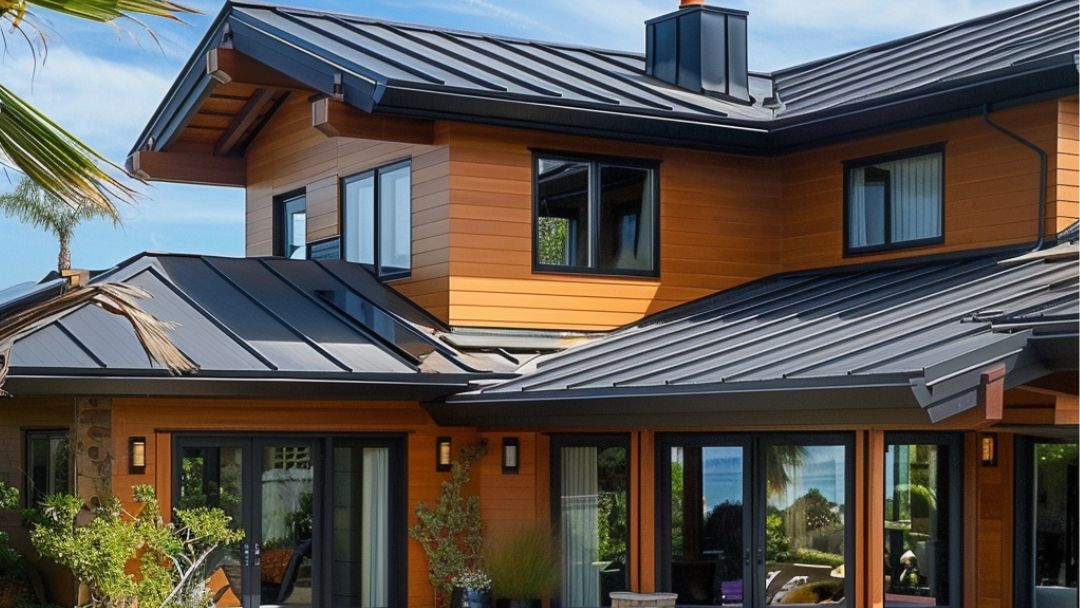
Choosing the Right Roofing Contractor: Making the Smart Choice
Local Expertise Matters: Why Homegrown Knowledge Counts
When it comes to roofing, choosing a local contractor with expertise in your specific area is crucial. Local contractors understand the unique climate challenges in San Diego County, such as intense sun, coastal salt air, and occasional storms. Their familiarity with local building codes and weather patterns ensures that your roof is designed and installed to withstand local conditions effectively.
Key Questions to Ask: Ensuring You Hire the Best
Before hiring a roofing contractor, it’s essential to ask the right questions. Inquire about their licensing and insurance to ensure they’re qualified and protected. Ask about their experience with your specific roofing material and whether they have local references. It’s also wise to discuss warranty options and the expected timeline for your project. A reputable contractor should be transparent, communicative, and willing to answer all your questions clearly, giving you confidence in their ability to handle your roofing needs.
Red Flags to Watch For: Avoiding Common Pitfalls
Beware of contractors who offer unusually low bids, lack proper credentials, or pressure you into quick decisions. These are often signs of unreliable or inexperienced professionals.
Final Words: Protecting Your Home from the Top Down
Your roof is one of the most critical elements of your home, providing protection, enhancing energy efficiency, and contributing to curb appeal. As we’ve discussed, understanding the various roofing materials, the importance of regular maintenance, and knowing when to repair or replace your roof are all vital steps in ensuring your roof’s longevity. By choosing reflective materials, ensuring proper insulation and ventilation, and considering solar panel installation, you can significantly boost your home’s energy efficiency and reduce your utility costs.
It’s also essential to be aware of common roofing issues like leaks, moss, and storm damage, and to address them promptly to avoid more extensive problems. Regular inspections, both by yourself and professionals, can help catch these issues early. Additionally, understanding the details of your roofing warranty and homeowner’s insurance ensures you’re prepared for any unexpected events.
When it comes time to work on your roof, selecting a local contractor with the right experience is crucial. Ask the right questions, and don’t ignore red flags that might indicate an unreliable contractor.
Taking a proactive approach to roof care is the best way to protect your home and maintain its value. Don’t wait until problems arise—schedule an inspection with a trusted local roofing contractor today to ensure your roof is in top shape for years to come.
Recent Posts
The Role of Metal Roofs in Boosting Property Value
New Metal Roofing Trends To Watch In 2025
Do you have any questions?
Contact us at the Gen819 office nearest to you or submit a business inquiry online
Contact Us










